How to Plant, Grow, and Care for Artichokes: Easy Success Strategies
- May 15, 2024
- 0 comment
Learn how to plant, grow, and care for artichokes with our easy success strategies for a bountiful harvest every season. If you’re eager to add artichokes to your garden, you’re in the right place. This guide provides essential tips and strategies for every stage—from planting to caring for your plants.
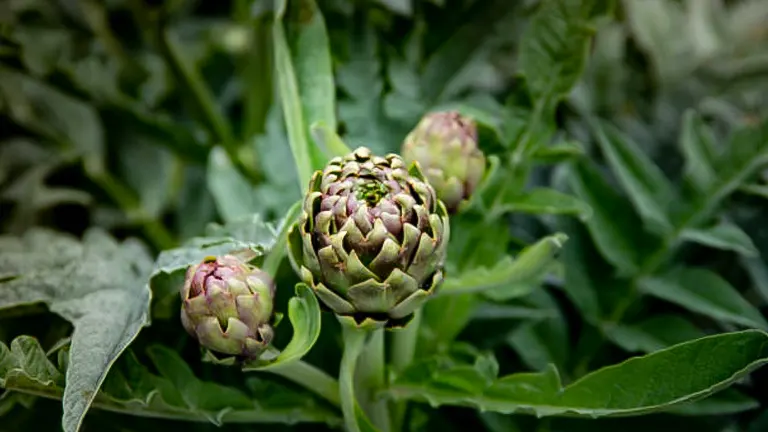
Follow these straightforward steps to ensure your artichokes thrive, yielding a plentiful and satisfying harvest. Let’s dive into the simple yet effective practices that will make growing artichokes a success.
Table of Contents
- Understanding Artichokes
- Pre-Planting Considerations
- Planting Artichokes
- Growing Strategies
- Common Pests and Diseases
- Harvesting and Post-Care for Artichokes
- Troubleshooting Common Issues
- Conclusion
- FAQs
Understanding Artichokes
Types and Varieties
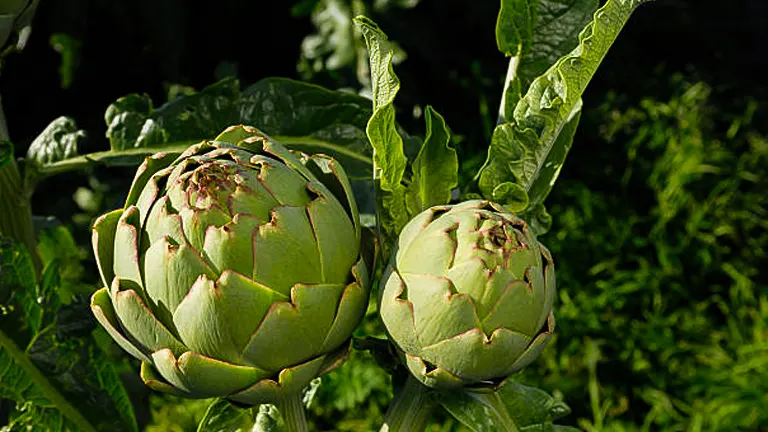
Artichokes are cultivars of Cynara cardunculus, originating from the Mediterranean region. This perennial thistle forms part of the Asteraceae family. Notable varieties include:
- Green Globe: This is the standard commercial variety in the United States, characterized by large, dense buds and a hearty tolerance to colder temperatures. It can grow up to six feet in height and four feet in width.
- Imperial Star: Developed to produce artichokes in the first year from seed, this variety is ideal for cooler climates and shorter growing seasons. It typically matures within 85-90 days and is less sensitive to photoperiod, making it a favorable choice for various latitudes.
- Violetto: Also known as ‘Purple Italian,’ this variety is distinguished by its striking purple buds and slightly spiny leaves. It thrives in warmer climates and brings a slightly nuttier flavor compared to its green counterparts.
Climatic Needs
Artichokes are adapted to Mediterranean climates, which provide moist, cool winters and warm summers. For successful growth, artichokes require a vernalization period—exposure to cold temperatures (below 50°F or 10°C) for about 200-400 hours—to initiate bud development. In non-native climates, growers can mimic these conditions to induce a productive growing season.
Soil and Nutritional Requirements
The ideal soil for artichokes is deep, fertile, and well-drained, with a loamy texture. They need a consistent supply of nutrients throughout the growing season, which can be managed through the application of a balanced 10-10-10 NPK (Nitrogen-Phosphorus-Potassium) fertilizer monthly. Enhancing soil with organic compost not only improves fertility but also increases soil microbial activity, which benefits plant health.
Nutritional Content and Health Benefits
Artichokes are a nutritious addition to any diet, offering a range of health benefits:
- Dietary Fiber: One medium artichoke contains about 10.3 grams of fiber, making it one of the top fiber-rich foods. This helps improve gut health and can assist in weight management.
- Antioxidants: Artichokes are loaded with antioxidants, including quercetin, rutin, anthocyanins, and silymarin, which help protect the body from oxidative stress associated with chronic diseases.
- Liver Health: The cynarin in artichokes not only affects cholesterol levels positively but is also known for its liver detoxification properties.
- Metabolic Benefits: Regular consumption of artichokes can help regulate blood pressure and blood sugar levels due to their high potassium and low sodium content.
Here’s a detailed nutritional chart for a deeper insight:
| Nutrient | Amount per 100g | % Daily Value* |
|---|---|---|
| Calories | 47 | — |
| Protein | 3.3 g | 7% |
| Total Fat | 0.2 g | <1% |
| Dietary Fiber | 5.4 g | 21% |
| Vitamin C | 11.7 mg | 13% |
| Vitamin K | 14.8 µg | 19% |
| Folate | 68 µg | 17% |
| Magnesium | 42 mg | 10% |
| Potassium | 370 mg | 8% |
*Percent Daily Values are based on a 2,000 calorie diet.
Pre-Planting Considerations
Soil Preparation

Artichokes require deeply worked, well-aerated soil to thrive. Begin by tilling the soil to a depth of 8 to 10 inches to loosen compacted earth and enhance root penetration. Introduce a generous amount of organic matter—such as compost, aged manure, or leaf mold—to enrich the soil. These amendments increase the soil’s nutrient profile and enhance its structure, significantly improving water retention and drainage capabilities. For a precise approach, incorporate 30% compost to your soil volume to optimize the nutrient balance and soil texture, beneficial for artichoke root systems.
Detailed Soil Composition Analysis:
- pH Level: Artichokes prefer slightly alkaline soil with a pH of 6.5 to 7.5.
- Organic Content: Target a minimum of 5% organic matter content for optimal growth.
- Drainage Rate: Ensure the soil has a good drainage rate to avoid waterlogging, which can lead to root diseases.
Climate and Seasonal Considerations
Artichokes are best suited to temperate climates but can adapt to a range of environmental conditions. They require a growing season with mild temperatures and low risk of frost. For regions experiencing harsh winters, consider growing artichokes as annuals, planting them early in the spring after the last frost or in late summer. This timing allows plants to establish themselves under ideal conditions without the stress of extreme temperatures.
Microclimate Effects
Creating a microclimate can mitigate less-than-ideal growing conditions. Utilize structures like walls or fences to shield plants from prevailing winds and to capitalize on reflected heat, which can extend the growing season in cooler regions.
Choosing the Right Location
The ideal location for artichokes offers full sun for at least six hours daily, which is crucial for optimal growth and bud development. Avoid areas prone to strong winds or provide windbreaks such as hedges or portable wind barriers to protect the artichokes’ large, delicate leaves from damage.
Spacing Guidelines
Correct spacing is critical to prevent overcrowding, reduce disease transmission, and ensure sufficient sunlight exposure. Here’s a detailed spacing chart based on garden size and machinery access:
| Garden Type | Plant Spacing | Row Spacing | Notes |
|---|---|---|---|
| Home Garden | 3 feet | 4 feet | Ideal for hand cultivation and easy access |
| Commercial Garden | 4 feet | 6 feet | Allows for machinery use, such as tillers |
Planting Artichokes
Planting Seeds and Seedlings
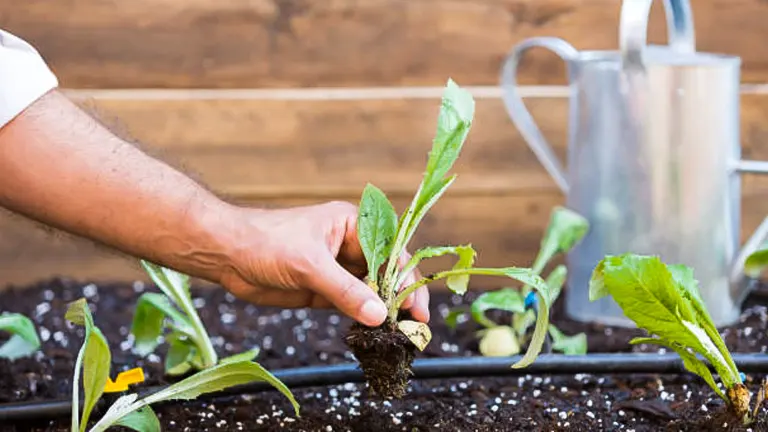
Artichokes can be started from seeds or seedlings, with seedlings generally offering more reliable results for new gardeners.
- Seeds: Begin by sowing seeds indoors about eight weeks before the last expected frost. Plant the seeds approximately 0.25 inches deep in soil trays or pots filled with a well-draining seed-starting mix. Maintain a consistent temperature of 70°F (21°C) to ensure optimal germination, which typically occurs within 10-14 days. Once the seedlings have developed their first true leaves and the outdoor temperatures are stable, they can be transplanted.
- Seedlings: Transplant seedlings into the garden at the same depth they were growing in their containers. This prevents the stems from being buried too deeply, which can hinder growth and increase the risk of disease. Ensure each seedling is well-spaced to accommodate its mature size.
| Planting Method | Depth | Ideal Temperature | Germination Time | Notes |
|---|---|---|---|---|
| Seeds | 0.25 inches | 70°F (21°C) | 10-14 days | Start indoors 8 weeks before last frost |
| Seedlings | Same as pot | Outdoor stable | N/A | Transplant after last frost |
Water and Nutrient Requirements
Artichokes need consistent moisture, particularly during the growing season, to support their large, fleshy buds.
- Watering: Use a drip irrigation system to provide even soil moisture, reducing the risk of waterborne diseases. Artichokes generally require about 1-1.5 inches of water per week. Monitor soil moisture and adjust watering frequency based on weather conditions.
- Nutrient Management: Artichokes are heavy feeders and benefit from regular fertilization. Apply a high-nitrogen fertilizer every 4-6 weeks during the growing season to support vigorous growth and bud development. Transition to a balanced NPK fertilizer as the plants begin to bud to encourage robust flower formation.
| Growth Stage | Nutrient Type | Application Frequency | Notes |
|---|---|---|---|
| Early Growth | High-nitrogen (10-10-10) | Every 4-6 weeks | Supports leaf and stem development |
| Bud Formation | Balanced NPK (5-10-10) | Every 6 weeks | Promotes healthy bud development |
Protecting Young Plants
Young artichoke plants are vulnerable to pests and environmental stressors, so proactive protection is essential.
- Pests: Common pests include aphids, slugs, and snails. Use floating row covers to shield young plants from these pests while allowing light and moisture to reach the plants. Regularly inspect the undersides of leaves and the base of the plants for signs of infestation.
- Environmental Stress: Protect plants from extreme temperatures using row covers or cold frames in cooler climates and shade cloths in hotter areas. Consistent monitoring and gentle care during the initial growth stages are crucial to establishing healthy, resilient plants.
- Additional Protection: Apply organic mulches, such as straw or compost, around the base of the plants to retain soil moisture and suppress weed growth. Mulch also helps regulate soil temperature, providing a more stable growing environment for young plants.
Growing Strategies
Watering and Feeding
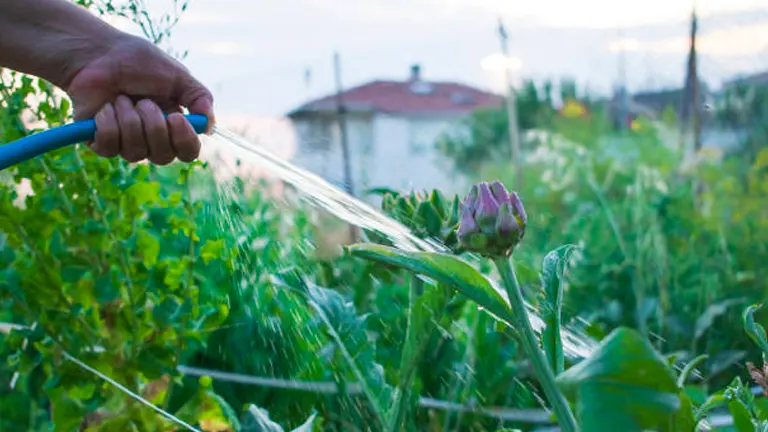
Consistent and appropriate watering is crucial for the healthy growth of artichokes, especially during their growth and bud formation stages. Artichokes should be watered deeply once or twice a week, depending on weather conditions, to ensure even soil moisture. Overhead irrigation should be avoided as it can increase the risk of leaf diseases like powdery mildew and botrytis. Drip irrigation is the preferred method as it delivers water directly to the root zone, minimizing foliage wetness.
- Water Requirements: Artichokes generally need about 1 to 1.5 inches of water per week. Adjust based on soil moisture levels and climatic conditions.
- Nutrient Management: Feed artichokes every four to six weeks with a balanced fertilizer (e.g., 10-10-10 NPK) to support robust growth and bud development. During the early stages, a high-nitrogen fertilizer is beneficial to promote leaf and stem growth. As the plant transitions to bud formation, switch to a balanced or phosphorus-rich fertilizer to enhance flower development.
| Growth Stage | Water Requirement | Nutrient Type | Application Frequency |
|---|---|---|---|
| Early Growth | 1 inch/week | High-nitrogen (10-10-10) | Every 4-6 weeks |
| Bud Formation | 1.5 inches/week | Balanced NPK (10-10-10) | Every 6 weeks |
Mulching
Applying a thick layer of organic mulch around the base of the plants is vital for moisture retention, weed suppression, and soil temperature regulation. Mulch materials such as straw, bark, or compost are effective. As these materials decompose, they also enrich the soil with additional nutrients.
- Mulch Depth: Apply mulch to a depth of 2-3 inches around the base of the plants, ensuring it does not directly contact the stems to prevent rot.
- Benefits: Mulch helps maintain consistent soil moisture, reduces weed competition, and can enhance soil structure over time.
Pruning Techniques
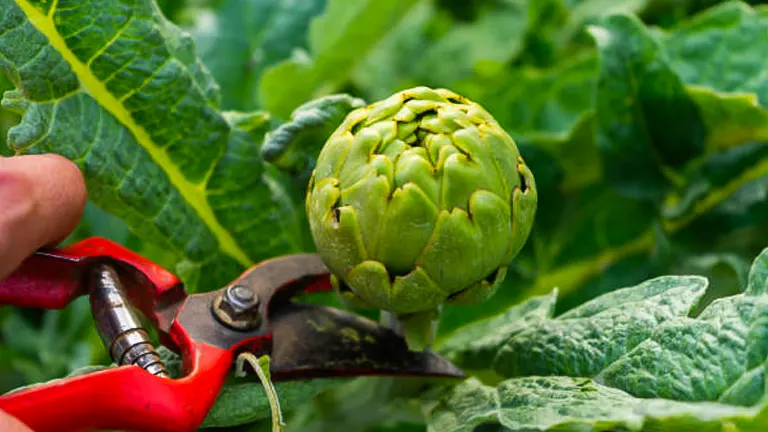
Pruning artichokes is essential for maintaining plant health and maximizing yield. Remove any damaged, diseased, or old leaves to improve air circulation, which reduces the risk of fungal diseases. During the growing season, selectively prune smaller buds to allow the larger ones to develop fully. This practice encourages the plant to direct its energy towards producing fewer but larger and higher-quality artichokes.
- Timing: Prune in early spring to remove winter-damaged leaves and during the growing season as needed.
- Tools: Use clean, sharp pruning shears to make clean cuts and reduce the risk of disease entry.
Managing Growth Phases
Artichokes exhibit distinct vegetative and reproductive phases. During the vegetative phase, focus on building a strong plant structure with healthy leaves. This phase requires high nitrogen levels to promote lush foliage. As the plant transitions to the reproductive phase, nutrient requirements shift. Reducing nitrogen and increasing phosphorus and potassium levels in your fertilization regimen supports bud development.
- Vegetative Phase: Prioritize nitrogen to promote foliage growth.
- Reproductive Phase: Shift to balanced or phosphorus-rich fertilizers to support flower bud development.
Common Pests and Diseases
Pest Identification and Management
Artichoke plants are prone to several pests that can hinder their growth and productivity. Here are the most common pests and strategies for managing them:
- Aphids: These small, sap-sucking insects can cause yellowing and curling of leaves. Use insecticidal soaps or neem oil to manage aphid populations. Encouraging natural predators like ladybugs and lacewings can also help keep aphids under control.
- Slugs and Snails: These pests feed on the tender parts of the plant, creating holes in leaves and stems. Use slug traps, copper barriers, or organic slug pellets to manage these pests effectively.
- Artichoke Plume Moth: The larvae of this moth bore into the stems and buds, causing significant damage. Monitor for moth activity and use Bacillus thuringiensis (Bt) or spinosad-based insecticides as needed.
| Pest | Symptoms | Management Strategies |
|---|---|---|
| Aphids | Yellowing, curling leaves | Insecticidal soap, natural predators (ladybugs) |
| Slugs and Snails | Holes in leaves and stems | Slug traps, copper barriers, organic pellets |
| Artichoke Plume Moth | Bored stems and buds | Bt, spinosad-based insecticides, monitoring |
Disease Prevention and Control
Artichokes are susceptible to several diseases, especially in humid conditions. The most common diseases include:
- Powdery Mildew: This fungal disease appears as a white, powdery coating on leaves and stems. Improve air circulation, avoid overhead watering, and apply fungicides if necessary.
- Botrytis (Gray Mold): This disease causes gray, fuzzy mold on leaves and buds. It thrives in wet, humid conditions. Ensure good air circulation, remove affected plant parts, and use fungicides if needed.
- Verticillium Wilt: This soil-borne fungus causes wilting and yellowing of leaves. It is challenging to control once established. Use disease-resistant varieties and practice crop rotation to prevent its spread.
| Disease | Symptoms | Prevention and Control Strategies |
|---|---|---|
| Powdery Mildew | White, powdery coating | Improve air circulation, avoid overhead watering, apply fungicides |
| Botrytis (Gray Mold) | Gray, fuzzy mold on leaves and buds | Ensure good air circulation, remove affected parts, apply fungicides |
| Verticillium Wilt | Wilting, yellowing leaves | Use resistant varieties, crop rotation |
Monitoring and Intervention
Regular monitoring and early intervention are crucial to managing pests and diseases effectively. Here are some best practices:
- Regular Inspections: Check your artichoke plants at least once a week for signs of pests or disease. Look under leaves, along stems, and at the base of the plant for any abnormalities.
- Early Detection: Identifying problems early can prevent widespread damage. Use magnifying glasses for detailed inspections if needed.
- Proactive Care: Adjust your care practices based on plant appearance and environmental conditions. For instance, increase air circulation if you notice signs of powdery mildew or adjust watering practices to prevent overwatering.
Additional Tips:
- Sanitation: Keep the growing area clean by removing plant debris and weeds, which can harbor pests and diseases.
- Mulching: Use organic mulch to suppress weeds, retain soil moisture, and improve soil health, which can indirectly reduce the risk of disease.
- Beneficial Insects: Encourage beneficial insects such as predatory beetles and parasitic wasps, which can help control pest populations naturally.
Harvesting and Post-Care for Artichokes
Harvesting Artichokes
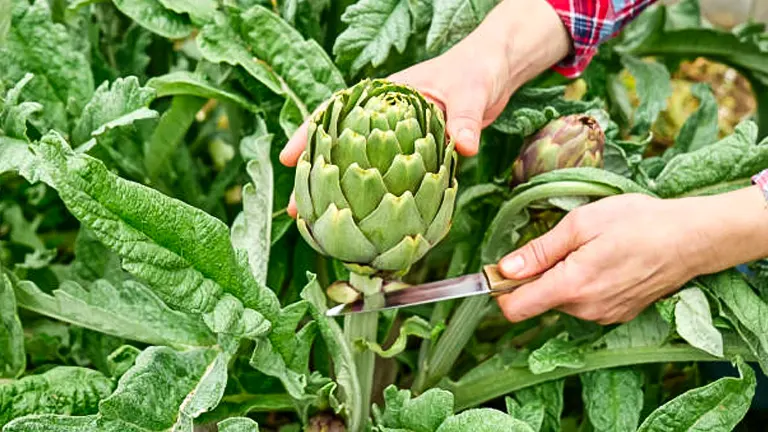
The ideal time to harvest artichokes is when the buds are firm and before the scales (bracts) begin to open. This typically occurs during late spring or early summer. The buds should feel tight, and the leaves should make a squeaking sound when pressed together, indicating their readiness. Use a sharp knife to cut the stem about one to three inches below the bud. Regular harvesting encourages the plant to produce more buds, extending the harvest period.
- Optimal Harvest Window: 85-100 days after planting, depending on the variety and growing conditions.
- Harvesting Frequency: Every 1-2 weeks during the peak season to ensure continuous bud production.
Post-Harvest Care
After the main harvest, it’s crucial to maintain proper care for your artichoke plants to prepare them for the next growing season.
- Watering: Continue to water the plants regularly to keep the soil consistently moist but not waterlogged. Artichokes require about 1-1.5 inches of water per week.
- Fertilization: Apply a balanced fertilizer (e.g., 10-10-10 NPK) to help the plants recover and strengthen for the next year. This supports overall plant health and promotes new growth.
Pruning Techniques
Post-harvest pruning is essential for maintaining plant health and encouraging further growth. This involves removing old, non-productive stems and any dead or damaged foliage.
- Pruning Steps:
- Remove Spent Buds: Cut back the stem just below the spent bud.
- Trim Dead Foliage: Remove any yellow or brown leaves to improve air circulation and reduce disease risk.
- Thin Out Stems: In late fall, cut back the main stems to ground level if the plant is being grown as a perennial.
Protection for Winter
In regions with mild winters, artichokes can continue to produce smaller buds throughout the summer and fall. In colder climates, additional protection is needed to ensure the plants survive winter.
- Winterizing Steps:
- Cut Back Foliage: Trim the plants back to about 6-8 inches above the ground.
- Apply Mulch: Apply a thick layer of organic mulch (e.g., straw, leaves, or compost) around the base of the plants to protect the roots from freezing temperatures.
- Cover with Frost Cloth: In areas with severe winters, consider covering the plants with a frost cloth or burlap for added protection.
| Care Aspect | Recommendation | Notes |
|---|---|---|
| Watering | 1-1.5 inches per week | Maintain consistent moisture |
| Fertilization | Balanced 10-10-10 NPK | Supports recovery and growth |
| Pruning | Remove spent buds and dead foliage | Enhances air circulation and health |
| Winter Protection | Mulch and cover with frost cloth | Protects roots from freezing |
Troubleshooting Common Issues
Solving Common Problems: Artichokes can face issues such as stunted growth, bud rot, or poor bud formation. Stunted growth often results from nutrient deficiencies or insufficient watering. Amend the soil with compost and ensure consistent watering. Bud rot can occur in overly wet conditions, so improve soil drainage and reduce watering frequency.
Reviving Struggling Plants: If artichokes appear wilted or unhealthy, assess their care regimen. They may require more nutrients, particularly if leaves are yellowing (a sign of nitrogen deficiency). Adjust your fertilization strategy accordingly. Check for signs of pests or disease and treat as needed without delay.
Ensuring Future Success: To ensure ongoing success, rotate your artichoke crops to different parts of the garden each year to prevent soil depletion and reduce pest and disease buildup. This practice also helps maintain soil health and fertility, essential for robust artichoke plants.
Related Post
- How to Fertilize Bougainvillea: A Complete Guide for Stunning Blooms
- How to Fertilize Apple Trees: Essential Tips for a Bountiful Harvest
- How to Fertilize Lemon Trees: Secrets for Thriving Citrus
- How to Fertilize Avocado Tree: A Step-by-Step Guide for Lush Growth
Conclusion
Growing artichokes can be a gratifying experience with the right knowledge and techniques. By following these easy success strategies for planting, growing, and caring for artichokes, you’re set to enjoy not only the beauty these plants add to your garden but also the delicious harvest they provide. Embrace the process and experiment with different practices to find what works best for your garden’s unique conditions.
FAQs
- What is the best time of year to plant artichokes?
In regions with mild winters, the best time to plant artichokes is either in early spring or late summer. For colder regions, early spring planting is ideal after the risk of frost has passed. - Can artichokes be grown in pots?
Yes, artichokes can be grown in pots, provided the container is large enough (at least 24 inches in diameter) and has good drainage. Potted artichokes need regular watering and feeding to compensate for the limited soil volume. - How often should artichokes be watered?
Artichokes require consistent moisture to thrive. Water them deeply once or twice a week, depending on the weather conditions, ensuring that the soil remains evenly moist but not soggy. - What are some common pests that affect artichokes, and how can they be managed?
Common pests include aphids, slugs, and artichoke plume moths. Manage these pests through integrated pest management strategies such as using insecticidal soaps for aphids, setting up slug barriers, and monitoring and removing moths manually. - How do I know when artichokes are ready to harvest?
Artichokes are ready to harvest when the buds are firm and the scales are still closed. If the leaves begin to open or the bud feels soft, it might be overripe. - What should I do with my artichoke plants in winter?
In colder climates, cut back the foliage after the first frost and apply a thick layer of mulch over the root area to protect it from freezing temperatures. In milder climates, simply reduce watering and continue to monitor for pests. - Can I grow artichokes from seeds, and if so, how?
Yes, artichokes can be grown from seeds. Start seeds indoors about eight weeks before the last expected frost. Plant the seeds about a quarter inch deep in a soil mix, keeping them moist and warm until seedlings develop. - Are there any specific fertilizers that are best for artichokes?
Artichokes benefit from high-nitrogen fertilizers, especially during the initial stages of growth. Once the plant starts to develop buds, switch to a balanced fertilizer to support all-around plant health and bud development.
We hope this guide inspires you to start your own artichoke garden. With these easy success strategies, you’re well on your way to enjoying fresh, home-grown artichokes. Happy gardening!

Emma Hudson
Forestry AuthorEmma's experience in farming shapes her detailed guides on gardening and farming tools, providing practical, actionable advice grounded in real-world experience. Her work targets both newcomers and experienced farmers, aiming to enhance their practices with a mix of traditional wisdom and modern techniques. By making complex agricultural concepts accessible, Emma's guides serve as valuable tools for those navigating the challenges of contemporary farming, offering strategies for sustainable success.













Leave your comment